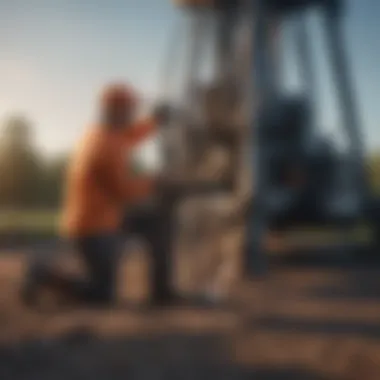Unveiling the Intricacies of Water Well Drilling Process


Overview of the Topic
Water well drilling is a fundamental process vital for obtaining access to groundwater resources. This article will delve into the intricate details encompassing every aspect of water well drilling, from its initial planning stages to the cutting-edge equipment and techniques required for its successful implementation. Within this comprehensive exploration, readers will gain a profound understanding of the crucial role that water well drilling plays in ensuring sustainable water resource management.
Background Information
The significance of water well drilling lies in its ability to serve as a primary method for acquiring groundwater resources, which are essential for various sectors, including agriculture, domestic usage, and industrial purposes. Recognizing the escalating global challenges related to water scarcity and contamination, the efficacy of water well drilling in providing a reliable and sustainable water source becomes increasingly indispensable.
Current Status and Challenges
Presently, the realm of water well drilling faces multifaceted challenges, ranging from technological limitations to environmental concerns. Issues such as aquifer depletion, groundwater contamination, and inadequate access to safe drinking water pose significant obstacles to effective water well drilling practices. Addressing these challenges necessitates innovative solutions and meticulous planning to uphold the integrity of groundwater sources.
Sustainable Solutions
In response to the pressing challenges confronting water well drilling, the adoption of sustainable practices has emerged as a pivotal solution. By incorporating environmentally-friendly drilling techniques, implementing watershed management strategies, and promoting community engagement in water conservation efforts, sustainable solutions aim to enhance the efficiency and longevity of water well systems.
Impact and Importance
The impact of water well drilling reverberates across ecosystems, communities, and future generations. Effective groundwater management through well-structured drilling projects not only safeguards natural resources but also fosters socio-economic development and resilience. Emphasizing the critical need for conservation initiatives and sustainable water resource management, it is imperative to recognize the enduring importance of responsible water well drilling practices in shaping a more sustainable future.
Introduction
Water well drilling is a fundamental process essential for accessing groundwater resources, making it a cornerstone in environmental sustainability and resource management. This article provides an in-depth exploration of the intricacies involved in water well drilling, from the initial planning stages to the utilization of advanced drilling techniques and specialized equipment. By delving into this crucial practice, readers will acquire a comprehensive understanding of the significance and complexities associated with water well drilling.
Understanding the Significance of Water Well Drilling
The importance of groundwater access
Groundwater access plays a pivotal role in catering to the increasing water demands of various industries, agricultural sectors, and communities worldwide. It serves as a dependable and sustainable source of water supply, particularly in regions facing water scarcity or contaminated surface water. The key characteristic of groundwater access lies in its reliability and quality, providing a consistent and uncontaminated water source for consumption and industrial purposes. This aspect of water well drilling proves beneficial by ensuring long-term water security and mitigating the risks associated with erratic surface water availability. Despite its advantages, challenges such as groundwater depletion and contamination underscore the need for responsible management practices in utilizing groundwater accessed through well drilling.
Role of water wells in addressing water scarcity
Water wells play a crucial role in mitigating water scarcity by offering a sustainable solution for water access in arid and drought-prone regions. They serve as strategic interventions to combat water stress and enhance community resilience against environmental challenges. The key characteristic of water wells in addressing water scarcity is their ability to tap into underground aquifers, providing a reliable and consistent water supply independent of climatic conditions. This feature proves advantageous by reducing dependence on unpredictable surface water sources and fostering self-sufficiency in water management. However, issues such as over-extraction and aquifer depletion highlight the importance of sustainable water usage practices to ensure the long-term availability of groundwater resources.
Planning Phase
In the realm of water well drilling, the Planning Phase stands as a critical pillar that lays the foundation for a successful outcome. It is during this phase that the intricate details of site selection, regulatory compliance, and drilling techniques are meticulously ironed out. The significance of the Planning Phase cannot be overstated, as it forms the backbone of the entire drilling operation. By meticulously planning every aspect of the project, from obtaining permits to assessing environmental impact, professionals can ensure a smooth and efficient drilling process.
Site Selection for Well Installation


Impact of geology on site selection
In the context of water well drilling, the Impact of geology on site selection plays a pivotal role in determining the feasibility and success of the project. Geology influences the choice of well location, affecting factors such as water quality, accessibility, and sustainability. By understanding the geological composition of an area, drillers can identify optimal sites that offer high water permeability and minimal contamination risks. This strategic approach to site selection based on geological considerations enhances the overall efficiency and output of the water well drilling process.
Considerations for optimal water flow
When delving into Considerations for optimal water flow, the focus shifts towards ensuring the seamless and continuous supply of water from the well. Factors such as aquifer characteristics, hydraulic conductivity, and well depth are meticulously assessed to optimize water flow rates. By incorporating these considerations into the planning phase, drillers can maximize the efficiency of water extraction, ultimately leading to a sustainable and reliable water supply. The emphasis on optimal water flow highlights the importance of strategic decision-making in enhancing the functionality and longevity of water wells.
Permitting and Regulatory Compliance
Understanding legal requirements
Navigating the intricate web of legal requirements is essential for the successful completion of a water well drilling project. Understanding legal requirements involves complying with legislation related to water rights, land use, and environmental protection. By adhering to these regulations, drillers can operate within the boundaries of the law, ensuring sustainable water resource management and mitigating potential legal complications. The thorough understanding and adherence to legal requirements form a crucial aspect of the Planning Phase, setting the groundwork for a legally and environmentally sound drilling operation.
Environmental impact assessments
Environmental impact assessments play a pivotal role in the Planning Phase of water well drilling, guiding decision-making processes to minimize ecological harm. By assessing the potential environmental consequences of drilling activities, professionals can implement mitigation measures to safeguard ecosystems and water quality. These assessments ensure that drilling operations are conducted in an environmentally responsible manner, promoting sustainable practices and biodiversity conservation. The integration of environmental impact assessments into the Planning Phase underscores a proactive approach towards environmental stewardship and resource protection.
Drilling Techniques
Water well drilling involves various crucial techniques that are essential for successful groundwater access. Understanding these drilling methods is paramount for anyone involved in well construction. It is imperative to grasp the specific elements, benefits, and considerations associated with these techniques to ensure optimal outcomes.
Rotary Drilling Method
The Rotary Drilling Method stands out as a cornerstone in the realm of water well drilling due to its efficiency and versatility. This technique involves the use of a rotating drill bit that creates boreholes in the ground. The key characteristic of the Rotary Drilling Method lies in its ability to penetrate various types of soil and rock formations effectively. This makes it a popular choice in the context of well drilling.
One of the most notable advantages of the Rotary Drilling Method is its capacity to reach considerable depths, allowing access to deep-seated water reservoirs that would otherwise be challenging to tap into. Additionally, this method offers greater precision and control during the drilling process, minimizing the risk of errors and setbacks. However, a potential disadvantage of rotary drilling is the generation of drilling waste that must be managed appropriately to prevent environmental harm.
Equipment Used in Rotary Drilling
The equipment deployed in rotary drilling plays a vital role in ensuring the success of well construction projects. From specialized drill bits to complex machinery, each component contributes to the efficiency and effectiveness of the drilling process. Among the key characteristics of equipment used in rotary drilling is their durability and precision, enabling them to withstand the rigors of drilling into tough geological formations.
The utilization of advanced technologies in rotary drilling equipment enhances the overall performance and speed of borehole creation. This sophisticated machinery streamlines the drilling operation, making it a preferred choice for meeting stringent project timelines and quality standards. However, one must also consider the maintenance and operational costs associated with sophisticated drilling equipment, balancing their benefits with financial considerations to achieve cost-effective drilling solutions.
Equipment and Tools
In the realm of water well drilling, the topic of Equipment and Tools holds paramount importance. The successful execution of drilling operations heavily relies on the quality, efficiency, and appropriateness of the equipment utilized. From the selection of drilling rigs to the precision tools employed, every component plays a crucial role in the overall effectiveness and safety of the drilling process. Ensuring that the equipment is well-maintained, modern, and in optimal working condition is fundamental to achieving the desired outcomes with efficiency and precision. The choice of equipment can significantly impact drilling productivity, operator safety, and the sustainability of the groundwater sources being accessed.
Drilling Rigs
Crawler-mounted rigs


Crawler-mounted rigs are a distinctive category of drilling rigs known for their exceptional maneuverability and stability on challenging terrains. These rigs are equipped with tracks instead of wheels, allowing them to navigate rugged landscapes with ease, providing access to drilling sites that may be inaccessible to other types of rigs. The key characteristic of crawler-mounted rigs lies in their ability to traverse uneven surfaces while maintaining balance and stability, ensuring consistent drilling performance even in adverse conditions. This feature makes them a preferred choice for remote locations or areas with limited accessibility, where traditional drilling rigs may struggle to operate effectively. Despite their advantages in navigating tough terrains, crawler-mounted rigs may have limitations in terms of speed and efficiency on smoother surfaces, requiring careful consideration based on the specific geological conditions of the drilling site.
Truck-mounted rigs
On the other hand, truck-mounted rigs offer a different set of advantages in the realm of water well drilling. These rigs are mounted on trucks, providing mobility and flexibility for quick setup and relocation between drilling sites. The key characteristic of truck-mounted rigs lies in their portability and rapid deployment capabilities, making them ideal for projects that require frequent repositioning or drilling in multiple locations. The unique feature of truck-mounted rigs is their versatility in addressing the varying needs of different drilling projects, offering a balance between performance and mobility. However, the compact nature of truck-mounted rigs may limit the scope of drilling depths or the size of equipment that can be accommodated, influencing their suitability for specific drilling endeavors. As with any equipment choice in water well drilling, the selection between crawler-mounted rigs and truck-mounted rigs should be guided by a thorough assessment of the project requirements, environmental factors, and expected outcomes to ensure optimal performance and efficiency.
Safety Measures and Precautions
Water well drilling is a precise and intricate process that demands strict adherence to safety measures and precautions at every stage. Emphasizing safety not only protects the workers but also ensures the integrity of the well and prevents environmental harm. Safety measures encompass a range of protocols and practices designed to mitigate risks and promote a secure working environment. By prioritizing safety, drilling operations can proceed efficiently and effectively.
Ensuring Worker Safety
In the realm of water well drilling, ensuring the safety of workers is paramount. The training requirements for drilling personnel play a crucial role in upholding safety standards on-site. Properly trained personnel are equipped with the knowledge and skills to handle the complexities of drilling operations, reduce accidents, and respond effectively to emergencies. This adherence to stringent training protocols enhances overall safety outcomes and minimizes the likelihood of workplace incidents.
Training requirements for drilling personnel
Training requirements for drilling personnel involve comprehensive instruction on the use of drilling equipment, safety procedures, and emergency protocols. Rigorous training programs ensure that workers are well-prepared to navigate potential hazards in the drilling environment. The structured curriculum covers a wide array of topics, including hazard recognition, protective measures, and proper equipment handling. These training initiatives contribute significantly to maintaining a secure working environment and safeguarding the well-being of personnel.
Use of personal protective equipment
Another critical aspect of ensuring worker safety in water well drilling is the utilization of personal protective equipment (PPE). PPE includes gear such as hard hats, safety glasses, gloves, and steel-toed boots, essential for shielding workers from potential injuries on-site. The implementation of PPE guidelines underscores a commitment to worker safety and underscores the importance of proactive risk management. By incorporating PPE into daily operations, drilling teams can reduce susceptibility to workplace accidents and promote a culture of safety excellence.
Environmental Protection
In addition to safeguarding worker safety, water well drilling operations must prioritize environmental protection. Environmental considerations are integral to sustainable drilling practices, aiming to minimize the ecological footprint and preserve natural resources. Safeguarding groundwater quality and ensuring responsible waste management are key components of environmental protection protocols in drilling activities.
Preventing groundwater contamination
Preventing groundwater contamination is a fundamental aspect of environmental protection in water well drilling. Implementing measures such as casing and grouting procedures, aquifer characterization studies, and regular monitoring helps prevent the infiltration of contaminants into the aquifer system. Proactive contamination prevention strategies are vital for maintaining the purity and safety of groundwater resources, essential for human consumption and ecosystem health.
Proper disposal of drilling waste
Proper disposal of drilling waste is essential to mitigate the environmental impact of drilling operations. Waste generated during drilling, including drilling muds, cuttings, and chemicals, must be handled and disposed of responsibly to prevent soil and water contamination. Adhering to waste disposal regulations, utilizing containment systems, and implementing recycling initiatives promote eco-friendly practices and ensure minimal ecological disturbance. By prioritizing proper waste management, drilling projects can operate sustainably and minimize their environmental footprint.
Completion and Maintenance
In the intricate process of water well drilling, the Completion and Maintenance stage holds utmost significance. This stage encompasses vital tasks essential for the functionality and longevity of the water well. Completion involves various procedures, with well development being a key focus. Well Maintenance, on the other hand, ensures that the well continues to deliver clean and safe water over time. Monitoring well health, performing necessary repairs, and implementing preventative maintenance measures are all part of this critical phase. Well Completion guarantees that the well functions optimally, providing the community with a reliable water source. Maintenance, on the other hand, is crucial for prolonging the well's lifespan and preserving water quality, making it indispensable in the grand scheme of water well drilling.
Well Development


Flushing and Cleaning Procedures
In the aspect of Well Development, Flushing and Cleaning procedures play a fundamental role in ensuring water quality and system efficiency. This stage involves the removal of debris, sediment, and residual materials that may have accumulated during the drilling process. Flushing entails pumping water into the well at a high velocity to dislodge any impurities or blockages, while cleaning involves physical removal of contaminants from the well components. The key characteristic of Flushing and Cleaning procedures lies in their ability to enhance water clarity and prevent clogging, thereby maintaining optimal well performance. Their operational simplicity and cost-effectiveness make them a popular choice in water well maintenance, ensuring consistent water flow and purity. The unique feature of these procedures is their non-invasive nature, preserving the well structure while promoting efficient water distribution, presenting clear advantages in sustaining water quality and system longevity.
Testing Water Quality
Testing water quality stands as a non-negotiable aspect of Well Development, safeguarding human health and environmental integrity. This process involves collecting water samples from the well and analyzing them for various contaminants, such as bacteria, heavy metals, and chemicals. The main objective is to ensure that the water is safe for consumption and complies with regulatory standards. The key characteristic of Testing water quality lies in its ability to identify potential health hazards and determine the efficacy of water treatment measures. Its thoroughness and accuracy make it a standard practice in well maintenance, providing valuable insights into water purity levels and potential risks. The unique feature of this testing method is its adaptability to different water sources and contamination profiles, offering a tailored approach to safeguarding water quality within the context of this article.
Routine Maintenance
Inspecting Well Components
Routine Maintenance of water wells involves inspecting various components to identify issues and prevent malfunctions. Examining the casing, pump, and screen for signs of corrosion, leaks, or damage is crucial for ensuring optimal well function. The key characteristic of inspecting well components is its proactive nature, enabling early detection of problems before they escalate. This preventative approach reduces the risk of costly repairs and disruptions to water supply, making it a preferred choice for sustainable well management. The unique feature of this maintenance practice is its accessibility and simplicity, allowing trained personnel to conduct regular checks efficiently, thereby maintaining well performance and longevity.
Repair and Rehabilitation
When inevitable wear and tear or damage occur, Repair and Rehabilitation come into play to restore the well to operational status. Repairing leaks, replacing worn-out parts, or rehabilitating casing integrity are common tasks undertaken during this phase. The key characteristic of Repair and Rehabilitation is their ability to extend the well's lifespan and sustain water quality standards. By addressing issues promptly and effectively, these actions prevent water loss, contamination, and system inefficiencies, ensuring continuous access to clean water. The unique feature of this maintenance aspect is its adaptability to different well structures and conditions, providing tailored solutions to maintain well performance and mitigate risks within the context of the article on water well drilling.
Challenges and Solutions
Water well drilling presents a myriad of challenges that necessitate innovative solutions to ensure successful project completion. The ability to address these challenges effectively is paramount for the sustainability and efficiency of water well drilling initiatives. One of the primary challenges encountered during drilling operations is the presence of hard rock formations in the subsurface. These formations can impede progress, increase drilling time, and require specialized equipment and techniques to navigate. Consequently, developing strategies to mitigate the impact of hard rock formations is crucial for the overall success of the drilling project. Additionally, another significant challenge faced during drilling is the issue of drilling fluid loss, which can lead to reduced efficiency, environmental contamination, and potential project delays. Implementing protocols to manage drilling fluid circulation and prevent loss is essential to optimize drilling operations.
Issues During Drilling
Encountering Hard Rock Formations
Encountering hard rock formations is a common obstacle in water well drilling that demands careful consideration and strategic planning. These formations are characterized by their high density and resistance to conventional drilling methods, posing a formidable hurdle for drilling teams. The presence of hard rock necessitates the utilization of advanced drilling tools, such as specialized drill bits and casings, to penetrate the formation effectively while maintaining borehole integrity. Despite the challenges posed by hard rock formations, successfully navigating these geological features can lead to accessing deeper water reservoirs and enhancing the overall efficiency of the water well. However, the process of drilling through hard rock formations requires meticulous attention to detail, as any misstep can result in equipment damage and drilling delays, highlighting the critical importance of skilled personnel and robust operational protocols.
Dealing with Drilling Fluid Loss
Efficient management of drilling fluid is essential to the success of water well drilling projects, with drilling fluid loss presenting a significant operational challenge. When drilling fluid is lost due to factors like formation porosity or inadequate containment, the consequences can range from reduced drilling efficiency to environmental hazards. Addressing drilling fluid loss involves implementing measures to control fluid circulation, optimize drilling parameters, and seal potential leakage points within the borehole. By adopting proactive approaches to mitigate drilling fluid loss, drilling teams can enhance operational safety, maintain environmental compliance, and maximize drilling productivity. Additionally, investing in high-quality drilling fluids with minimal environmental impact can contribute to sustainability efforts and regulatory adherence in water well drilling operations.
Future Trends in Water Well Drilling
Water well drilling is a constantly evolving field, with future trends playing a pivotal role in shaping the industry. As water resources become increasingly strained, innovation in drilling technologies becomes crucial. This section delves into the emerging trends that are revolutionizing water well drilling processes, offering insights into the advancements that are steering the sector towards a more sustainable and efficient future.
Innovation in Drilling Technologies
Innovation in drilling technologies is at the forefront of revolutionizing water well drilling practices. Two key aspects driving this innovation are advancements in downhole drilling tools and automation in drilling processes.
Advancements in Downhole Drilling Tools
Advancements in downhole drilling tools have significantly enhanced the efficiency and accuracy of well drilling operations. These tools utilize state-of-the-art technology to navigate complex geological formations with precision and speed. One key characteristic of these advancements is their ability to streamline the drilling process, reducing both time and resource consumption. This efficiency is a game-changer in the industry, allowing drilling projects to be completed in a more cost-effective manner. Additionally, the unique feature of real-time data collection provides drillers with valuable insights into subsurface conditions, optimizing decision-making throughout the drilling process. While these advancements offer a wide array of benefits, challenges such as initial investment costs and maintenance requirements must be carefully considered to ensure their cost-effectiveness in water well drilling projects.
Automation in Drilling Processes
Automation in drilling processes represents a significant leap forward in enhancing drilling efficiency and safety. The key characteristic of automation is its ability to streamline drilling operations through advanced robotics and artificial intelligence. This automation eliminates human error and ensures consistent performance, ultimately leading to faster drilling times and increased productivity. The unique feature of unmanned drilling rigs further enhances safety by reducing human exposure to hazardous working conditions. While the advantages of automation in drilling processes are vast, challenges related to technology integration and workforce adaptation need to be addressed to fully capitalize on its potential in water well drilling projects. Overall, automation presents a promising future in enhancing drilling precision, efficiency, and safety in the water well drilling industry.



